Asif M Basit, Ahmadiyya Archive & Research Centre
While some of the prophecies of Hazrat Mirza Ghulam Ahmadas of Qadian were aimed at proving Islam’s supremacy to people of other faiths, like Christians and Hindus, a particular prophecy was aimed at Muslims who had turned against Islam so much so that they facilitated Hindus and Christians in deforming the teachings of Islam and propagating blasphemous rumours about the Holy Founder of Islam, Hazrat Muhammadsa.
This group of Muslims – the primary target of this prophetic warning – belonged to the greater family of the Promised Messiahas. They were Huzoor’sas first cousins, namely Mirza Imam-ud-Din and Mirza Nizam-ud-Din (alt. spellings Imamdin, Nizamdin) who are more commonly known for persecuting the Promised Messiahas for his religious claims. But the fact of the matter is that they had turned against Islam altogether; hurling abuse at the Holy Prophetsa, desecrating the Holy Quran, and mocking the existence of God had become matters of routine.
Before we delve deeper into this prophecy – the prophecy regarding Ahmad Beg and his daughter Muhammadi Begum – it is important to note that the Promised Messiahas tried to keep this domestic matter private (for being related to family) and not publicise it. He warned these relatives on many occasions – verbally and in writing – but the first to make the affair a public one were those whom he addressed.
This prophecy unfolded through a series of events and then accumulated into its final phase – the one now commonly known as the prophecy of Muhammadi Begum. The series of these prophetic warnings span a period of seven years (1885-1892) from one angle and over a period of twenty-three years from another (1885-1908).
Mirza Imam-ud-Din Beg, the first cousin of the Promised Messiahas, had had a change of heart and had turned away from Islam. This became manifest when he became the leader of a Hindu caste-faith known as Lal Begis. This caste was seen as among the lowest class of Hindus and worked as sanitary labour, more commonly known as Chuhras.
Not only was this class seen as the lowest stratum of the Hindu class system, but they were not even included in the four-fold varna of Hindu castes – where the fourth one is that of the untouchables. This class, for its profession and genealogy, was seen as outside of the four varnas and as a fifth varna. Hence, despite being Hindus in faith, they were not taken as belonging to the Hindus.
This led them to create a heretical sect where they venerated leaders from within their own class, with Lal Beg being their venerated saint. They had gotten to be known as Lal Begis and traced their teachings to Valmiki (alt. Balmiki) – the original poet of the Ramayana. However, their teachings transpired into a combination of Hinduism, Sikhism, and Islam – into a most distorted form of all three. (For details on the Lal Begi faith, see The Genealogies of Lal Beg, in The Legends of the Panjab by Captain RC Temple)
Some sections of this sect would have one of the three faiths dominate the teachings, and it would be taken to fall under that religion, although it always remained Hindu in essence.
Mirza Imam-ud-Din had become a patron-leader of this sect of Hindus, and, as recently found document facts suggest, he was himself a follower of this faith. I present below a never-before-seen book written by Mirza Imam-ud-Din which is sufficient proof of how he was distorting Islam by mixing it with the Balmiki faith.
The book is called Deed-e-Haq (Sighting of God) and explains to the Lal Begis in detail what they are supposed to believe and practice. His name appears as “talif Mirza Imam-ud-Din, ma’ruf ba maula-e-hidayat kuninda qaum Lal began” (written by Mirza Imam-ud-Din, known as the guiding lord of the Lal Begi people).
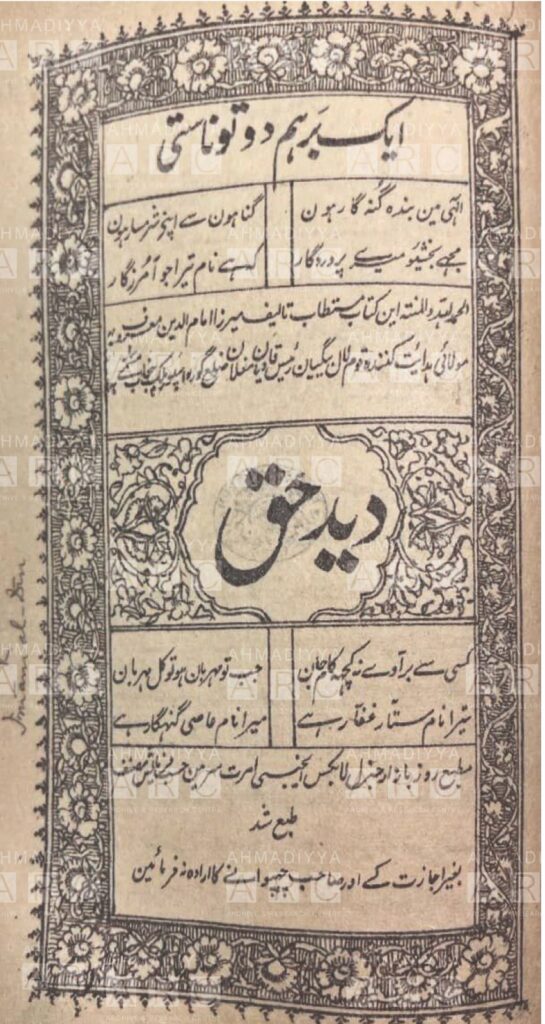
The foreword, the author of which is not mentioned at the end, appears to be written by a Lal Begi, and reads:
“Thousands of thanks to God, that as the religious teachings of our insightful pir Balmik Sahib were becoming distinct through the neglect of his people, he has ignited this lamp through a very pious person, Mirza Imam-ud-Din of Qadian, district Gurdaspur, who has rejuvenated the teachings of Balmik Sahib. […]” (Deed-e-Haq, p. 5)
The Lal Begi beneficiary of Mirza Imam-ud-Din goes on to sing praises of how the latter has done what he could to establish the Balmik faith; how much he has spent, how much care and compassion he has shown, and how he has written the book purely to revive the Balmiki faith.
One of the future projects mentioned is Imam-ud-Din’s desire to build a Balmik shrine for his followers, i.e., the Lal Begis, in Qadian.
The contents of the book, in the words of Imam-ud-Din, go on to explain the dos and don’ts for Lal Begis, with a clear instruction:
“O Lal Begis! Do not go towards any other religion and stick strictly on the path of Pir Balmik. […]” (Ibid., p. 7)
“My desire is that you stay on your path and do not seek to follow any other religion. […]” (Ibid., p. 9)
“There is no special god in mosques who is their friend and your enemy. You should build your own temple to remember god. […]”
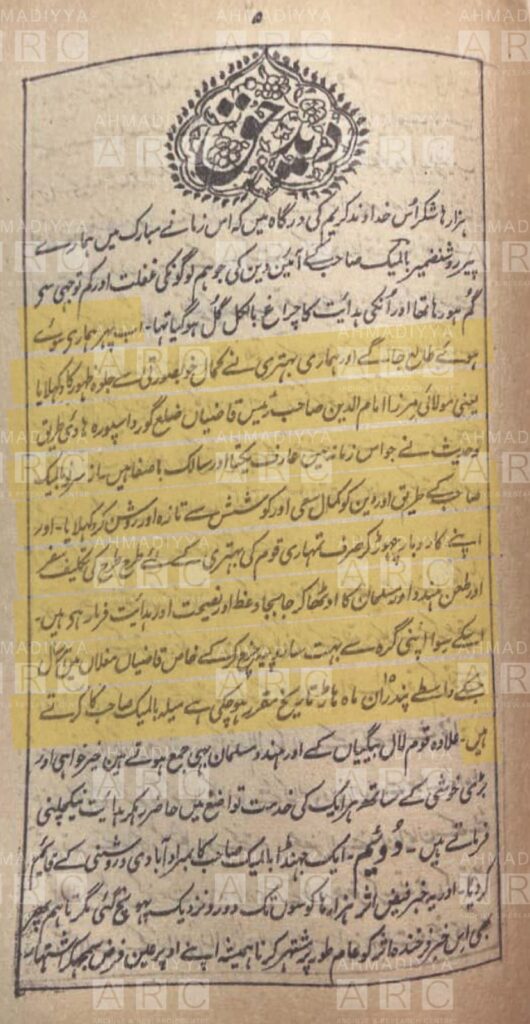
Imam-ud-Din goes on to remind them of their prayers and gives advice on new ways of praying where everyone stands facing each other and says special mantras, which Imam-ud-Din spells out for them; before telling them that “you ought to take these instructions as god’s words […]” (Ibid., p. 18).
Another never-before-seen evidence of this family’s transgression is Imam-ud-Din’s book titled Gul-e-Shaguft (Blossoming Flower).
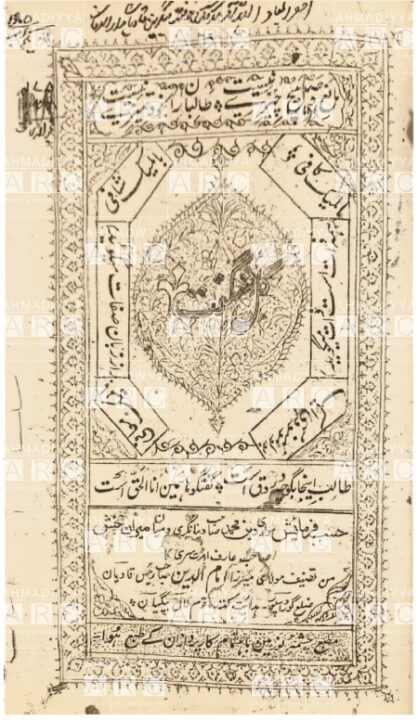
The title page has on it, boldly written all across, the words:
Balmik kafi, Balmik shafi, Balmik ma’fi (Balmik is sufficient, Balmik cures, Balmik forgives)
This is clearly what the Promised Messiahas meant when he mentioned, with much heartfelt pain, that this family had turned away from and turned against God altogether.
As specimen, I present only a few statements from this book:
“Jesus is the only son of God and Muhammad is only a friend” (Gul-e-Shaguft, p. 8)
“Muslim God is in human form; let’s praise the God of Balmik” (Ibid, p. 12)
The print-line of the book does not state the year of print, but a statement within locates this book in 1899, where he states:
“It has been 1899 years that Jesus existed…” (Ibid, p. 6)
Also, a reference to the Ahmad Beg prophecy is made but only mentions that Muhammadi Begum’s husband would die in three years, but this hadn’t happened and Muhammadi Begum is happily married and has mothered Sultan Muhammad’s children.
Quite slyly, he leaves out the fact that Muhammadi Begum’s father was meant to die in three years after the marriage, which he did.
Howsoever sad this falsehood may be, it goes to show where opponents of the Jamaat got this attitude from – from the guru of Lal Begis.
This is how this line of the Promised Messiahas had derailed their faith into obscurity and absurdity. The family, spearheaded by Imam-ud-Din had no respect left for the Holy Prophetsa and the holy teachings of Islam. And it was this state of affairs that led the Promised Messiahas, acting on divine instruction, to issue them a prophetic warning. He says about Imam-ud-Din and Nizam-ud-Din:
“God Almighty saw my paternal cousins [chacha-zad bhai] and other close relatives that they are indulged in soul-crushing activities; drowned in ill innovations, and false beliefs […]. They deny the existence of Allah the Almighty and are always after creating mischief. […]” (Aina-e-Kamalat-e-Islam, Ruhani Khazain, Vol. 5, pp. 566-567)
“They would ridicule the words of Allah and his Messenger; even saying that the Quran is nothing but meaningless words. […]” (Ibid., p. 568)
In August 1885, these cousins of the Promised Messiahas published a tract wherein they demanded a sign, and said that they wouldn’t take anything as a sign unless it appears within their family. The Promised Messiahas prayed fervently to Allah the Almighty and received the following revelation:
“I [God Almighty] have seen their transgression and rebellion, so I will afflict various calamities upon them and will destroy them … and demolish them; you shall see what I shall do to them. I have power over everything. Their women will turn into widows and their children into orphans; their houses will become barren, so they can taste what they asked for. But I shall not kill them all at once, but gradually so that they can repent and turn to God […]. All of them are accursed, save those who perform good deeds and severed their ties with them and avoided their company. […]” (Ibid., pp. 569-570)
The addressees of this divine warning paid no heed and continued in their mischief and transgression.
In the same month of this blasphemous tract being published, i.e., August 1885, the Promised Messiahas received a revelation from Allah, which he mentions as such:
“I received a revelation regarding Imam-ud-Din and Nizam-ud-Din that within a period of thirty-one months, a severe calamity would strike them; that someone from their family would die, leaving them in intense shock and trauma. This will happen from today’s date, which is […] 5 August 1885. And just as had been foretold, in the thirty-first month after this revelation, Nizam-ud-Din’s daughter passed away at a young age, leaving behind a newborn child.” (Tadhkirah, p. 103)
Similarly, the Promised Messiahas had recorded another vision in 1886 where he saw the mother of Nizam Din and Imam Din, who was the grandmother of Muhammadi Begum, in distress and agony. In the vision, the Promised Messiahas said to her: “Repent, repent! Or calamity shall befall your daughter or your granddaughter.” (Tadhkirah, revelation of 1886, pp. 107-108)
By this time, Muhammadi Begum was nowhere in the picture.
Around the same time, Nizam-ud-Din and Imam-ud-Din responded by approaching enemies of not only the Promised Messiahas, but enemies of Islam. They approached Pundit Lekhram, who was notorious all over India for the shameless, foul-mouthed opposition to the Prophetsa of Islam and the Holy Quran. They urged him to challenge the Promised Messiahas by asking for a sign from God, which he did. (Tarikh-e-Ahmadiyyat, Vol. 1, p. 317)
This collaboration with the notorious Islamophobic Lekhram is evident from the tract written by Mirza Imam-ud-Din, published under the auspices of Lekhram, and later included in his book Takzib Barahin-e-Ahmadiyya, as part of a special appendix titled Zamima Kitab Haza Babat Khatut-o-Ishtiharat (Appendix on Letters and Tracts):
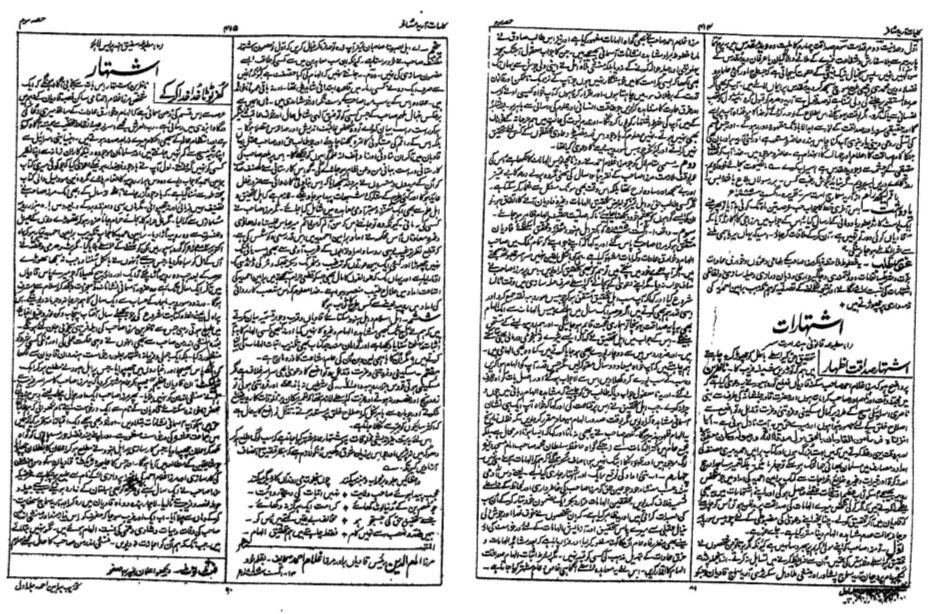
It is signed by “Mirza Imam-ud-Din, Chief of Qadian, brother of Mirza Ghulam Ahmatd, baqalam khud [autograph]” and dated 13 August 1885.
The contents of the tract invites everyone, Muslim, Hindu, or Christian, to urge the Promised Messiahas to produce any sign, and guides them on how to reject any sign by setting the criteria of fulfilment at a ridiculous and unrealistic threshold.
What we see here is how these so-called Muslim relatives of Hazrat Mirza Sahibas approached anti-Islam Hindus and joined hands against Islam. They went on to print and publicise a tract against Islam, the Prophetsa of Islam and the teachings of Islam. It became evident that their thoughts were deeply inspired by Hindu anti-Islamic propaganda, as we have seen in Imam-ud-Din’s book quoted above. They mocked the marriage of a girl to her mother’s cousin as being a marriage between a real niece and a real uncle, and presented as an example the Holy Prophet’ssa marriage to Hazrat Zainabra. This is an important point about the Holy Prophet’ssa marriage that must be kept in mind.
Now, where, when, and why does Muhammadi Begum come into the picture?
Muhammadi Begum comes into the picture
In 1888, Mirza Ahmad Beg approached the Promised Messiahas requesting that he sign a legal document so that a certain piece of land could be transferred to them. Upon this, the Promised Messiahas asked to be given some time to pray, as he did before in important matters. It must be noted that this Ahmad Beg was the father of Muhammadi Begum, and husband of the sister of Imam-ud-Din and Nizam-ud-Din – the mother of whom had appeared in the Promised Messiah’sas dream in a state of anguish and distress and was warned about a calamity that was waiting to strike her family.
The Promised Messiahas got back to them the following day and told them that Allah had instructed him to ask for the hand of Ahmad Beg’s daughter, Muhammadi Begum. This reminds us of how the Holy Prophetsa had won the hearts of clans and tribes after he married their women like Jaweria, Umm Habiba, and Safiya, and also how the hearts of enemies like Abu Sufyan and the chief of a Jewish tribe, Huyayy ibn Akhtab, softened for Islam after marrying their daughters to the Holy Prophetsa. So the Promised Messiahas, walking in the footsteps of his Holy Master, did the same, and that too on divine instruction.
Ahmad Beg immediately turned down the proposal, upon which he was warned by the Promised Messiahas that should he marry his daughter Muhammadi Begum elsewhere, he would be struck by death within three years of marrying her; and whoever she is married to would die within two and a half years. (Eik Peshgoi Pesh az Waqu ka Ishtihar [Announcement of a Prophecy before its Manifestation], Majmu‘ah-e-Ishtiharat, Vol. 1, p. 136)
Ahmad Beg, on this occasion, went to none else but the anti-Islam Christian newspaper Nur Afshan and had this private correspondence about his daughter published. (Aina-e-Kamalat-e-Islam, Ruhani Khazain, Vol. 5, pp. 287-288)
The tabloid got fuel for its rusty engine and published all sorts of gossip and mockery about this proposal of the Promised Messiahas to marry the daughter of a distant cousin. I must remind the readers of the case of Hazrat Zainab’sra marriage to the Holy Prophetsa.
The Promised Messiahas clarifies the background of this prophecy in Aina-e-Kamat-e-Islam:
“The base of this prophecy was not to randomly ask for the hand of Mirza Ahmad Beg’s daughter, but to show a sign to my close relatives who had turned against Islam, and one of them had progressed so much in mischief as to openly hurl abuse at Allah the Almighty and the Messenger of Allah […] even mocking the Islamic modes of worship […].” (Ibid., pp. 320-321)
But these ill-fated family members of Hazrat Mirza Sahibas collaborated with Hindus and joined hands with Christian missionaries whose bread and butter lay in mockery of Islam and its holy founder. This formed a block of anti-Islam Hindus, anti-Muslim Christians, and faithless Muslims acting against Islam in the garb of Islam.
Now, before moving on, let us go back to the words of the prophecy that was made well before Muhammadi Begum was in the picture, and is presented above.
Allah had said: “But I shall not kill them all at once, but gradually so that they can repent and turn to God […]. All of them are accursed, save those who perform good deeds and severed their ties with them and avoided their company […].”
So the prophecy remains, very Islamically so, one of wa‘eed and is, hence, inherently subject to be reversed through repentance; and this had been the whole basis from the start.
However, Ahmad Beg married his daughter, Muhammadi Begum, to Mirza Sultan Muhammad Beg in April 1892 and, as he had been warned, died in September of the same year – just five months after marrying away his daughter. This is very straightforward and requires no comments. The first part of the prophecy was fulfilled.
This cast a very dark shadow of fear on the hearts of the family, and although they did not accept the Promised Messiahas, he was approached by them, requesting to somehow take away the prophesied catastrophe from their family. He reminded them that the only way was to repent and refrain from blasphemy towards Islam and its holy founder. (Haqiqatul Wahi, Ruhani Khazain, Vol. 22, p. 195; Zamima Anjam-e-Atham, Ruhani Khazain, Vol. 11, p. 337)
While we do not have copies of such correspondence or any other documentary evidence, the fact that the Promised Messiahas continuously published their requests and that no one came forward to deny the correspondence, it can be seen as ample proof of the fear that had struck the family.
After a period of two and a half years, opponents started questioning the Promised Messiahas as to why Sultan Muhammad had not passed away. The Promised Messiahas would reply that the death of Ahmad Beg had shook the whole family to the core, including Sultan Muhammad, the husband of Muhammadi Begum and the family refrained from any mockery against Islam and its Holy Founder, Prophet Muhammadsa.
I have gone through newspapers from those years and have been unable to find any statement published by Sultan Muhammad, denying the bold and very clear-cut claim of Hazrat Mirza Sahibas that fear had struck the family and that they had hence refrained from their un- and anti-Islamic practices.
The most important aspect to remember is that the words of the prophecy stated that if Muhammadi Begum is married elsewhere, then her husband shall die and, and as a widow, she will enter the nikah of the Promised Messiahas. So she had to be widowed before her marriage to the Promised Messiahas.
The fear that held Sultan Muhammad from being blasphemous against Islam, and never denying that he was struck with the fear of Allah, kept him from becoming a target of the prophecy, making him a beneficiary of the exception clause of the prophecy. He outlived the Promised Messiahas, and so did Muhammadi Begum.
The Promised Messiahas, in the latter part of his life (1906), wrote in his book, Haqiqatul Wahi that his marriage to Muhammadi Begum, which was settled in the Heavens, had either been nullified (faskh-e-nikah) or postponed. (Tatimah Haqiqatul Wahi, Ruhani Khazain, Vol. 22, p. 570)
Hence, the bitter opponents of Islam, and their Hindu and Christian accomplices, were able to see both aspects of the prophecy: the death of Mirza Ahmad Beg and the repentance of Sultan Muhammad.
The Ahmadiyya publication Tasheez al-Azhan, in its issue dated 5 May 1913 published a letter written by Sultan Muhammad stating that he believed that the prophecy was fulfilled and that he had developed the fear of God in his heart. The letter read:
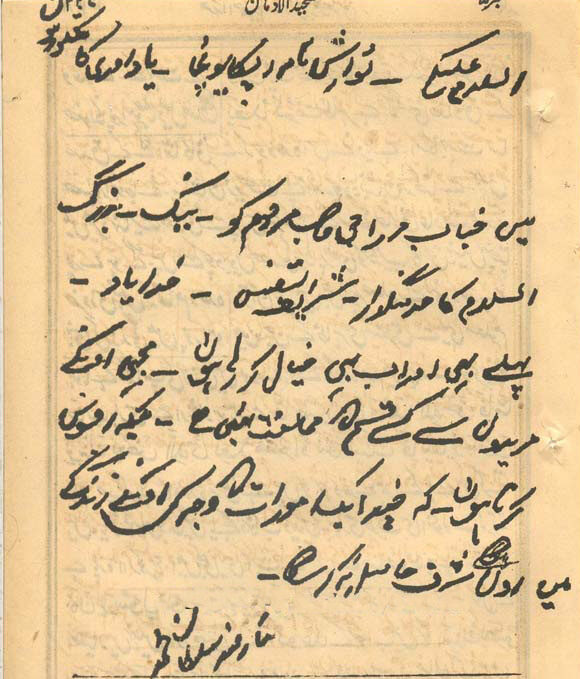
“Assalamo alaikum. I am in receipt of your letter. I am thankful for reaching out.
“I have seen, and still see, the late Mirza Ji as a pious, saintly, noble, and God-fearing person. I hold nothing against his followers; rather, I regret that a few issues prevented me from reaching out to him in his lifetime.
“Sincerely
“Sultan Muhammad
A whole decade later, Sanaullah Amritsari, in his periodical Ahle Hadith (14 March 1924), published statements attributed to Sultan Muhammad denying any fear or repentance, and professing that he had remained unaffected by the Promised Messiah’s prophecy.
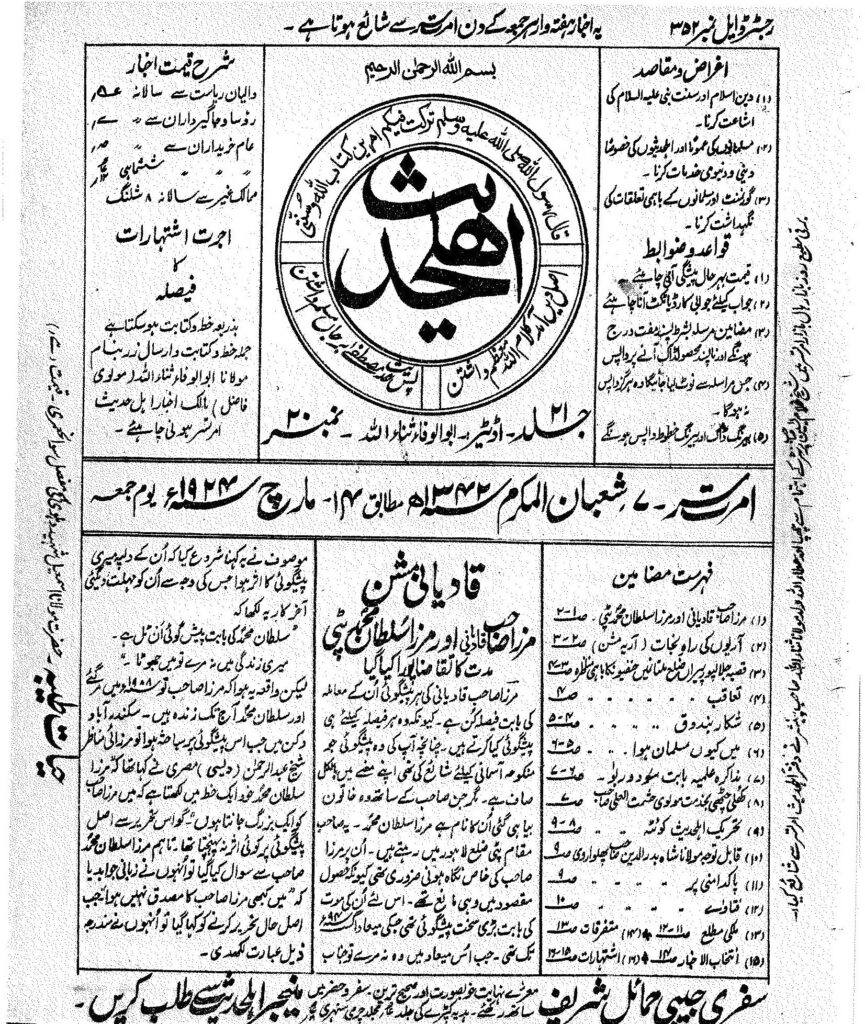
However, the Ahmadiyya publication had published his handwritten letter in 1913, which he never denied. His denial in the non-Ahmadi newspapers mentioned above was not accompanied by any handwritten note.
But for argument’s sake, if the benefit of the doubt is given to the non-Ahmadi publications, and it is taken that he had his denial published a decade later, the fact still stands undeniable that during the lifetime of the Promised Messiahas, he published no denial whatsoever.
So, we close by reminding the readers that Sultan Muhammad never indulged in the anti-Islamic activities of his in-laws. He never became a target of the prophecy and was saved by the exception clause of the same prophecy. Hence Muhammadi Begum never became widowed, and, hence, never entered the nikah of the Promised Messiahas. (Ishtihar Nusrat-e-Din wa Qata’ az Aqarib Mukhalif-e-Din (Announcement regarding help for the faith and severing ties with close relatives who oppose the Faith), in Majmua-e-Ishtiharat, Vol. 1, p. 237, reprint 2019; Aina-e-Kamalat-e-Islam, Ruhani Khazain, Vol. 5, p. 325)
Should more facts and data become available, the author will continue to share them with the readers; just as they have been shared today in the form of Imam-ud-Din’s book on his strange religion, which attacked Islam in a very shameless manner.
In the meantime, we leave the readers to decide whether they want to side with the Lal Begis, or with the one who championed Islam and saved it from any attack from anyone and any side.

